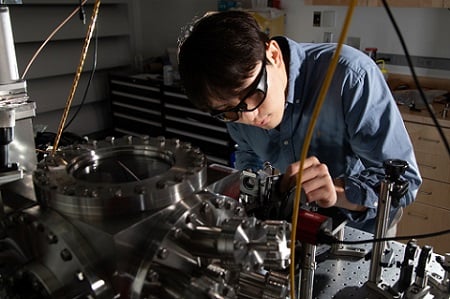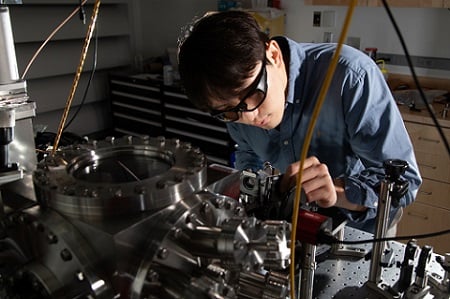CAMBRIDGE, Mass., May 26, 2025 — One of the most profound open questions in modern physics is: “Is gravity quantum?”
The other fundamental forces — electromagnetic, weak, and strong — have all been successfully described, but no complete and consistent quantum theory of gravity yet exists.
“Theoretical physicists have proposed many possible scenarios, from gravity being inherently classical to fully quantum, but the debate remains unresolved because we’ve never had a clear way to test gravity’s quantum nature in the lab,” said Dongchel Shin, a Ph.D. candidate at MIT. “The key to answering this lies in preparing mechanical systems that are massive enough to feel gravity, yet quiet enough — quantum enough — to reveal how gravity interacts with them.”
Shin researches quantum and precision metrology platforms that probe fundamental physics and are designed to pave the way for future industrial technology. He is the lead author of a recently published paper that demonstrates laser cooling of a centimeter-long torsional oscillator.
Lasers have been routinely employed to cool down atomic gases since the 1980s, and have been used in the linear motion of nanoscale mechanical oscillators since around 2010. The current research presents the first time this technique has been extended to torsional oscillators, which are key to a worldwide effort to study gravity using these systems.
“Torsion pendulums have been classical tools for gravity research since [Henry] Cavendish’s famous experiment in 1798. They’ve been used to measure Newton’s gravitational constant, G, test the inverse-square law, and search for new gravitational phenomena,” Shin said.

Dongchel Shin, a Ph.D. candidate at MIT and lead author of a paper demonstrating laser cooling of a centimeter-long torsional oscillator, works on an optical setup. Courtesy of MIT/Tony Pulsone.
“By applying laser cooling techniques originally developed for atoms to a centimeter-scale torsional oscillator, we try to bridge the classical and quantum worlds,” Shin said. “This hybrid platform enables a new class of experiments — ones that could finally let us test whether gravity needs to be described by quantum theory.”
The work demonstrated laser cooling of a centimeter-scale torsional oscillator from room temperature to a temperature of 10 mK using a mirrored optical lever.
“An optical lever is a simple but powerful measurement technique: You shine a laser onto a mirror, and even a tiny tilt of the mirror causes the reflected beam to shift noticeably on a detector. This magnifies small angular motions into easily measurable signals,” Shin said.

While the premise is simple, the team faced challenges when the technique was put into action. Air currents, vibrations, or imperfections in the optics can cause the beam to jitter, and those jitters can falsely appear as motion of the mirror, which limits the researchers’ ability to measure true physical signals, Shin said.
To overcome this, the team used the mirrored optical lever approach, which employs a second, mirrored version of the laser beam to cancel out the unwanted jitter.
“One beam interacts with the torsional oscillator, while the other reflects off a corner-cube mirror, reversing any jitter without picking up the oscillator’s motion,” Shin said. “When the two beams are combined at the detector, the real signal from the oscillator is preserved, and the false motion from [the] laser jitter is canceled.”
This approach reduced noise by a factor of a thousand, which allowed the researchers to detect motion with extreme precision, nearly 10× better than the oscillator’s own quantum zero-point fluctuations.
Shin said this work is just the beginning. “While we’ve achieved quantum-limited precision below the zero-point motion of the oscillator, reaching the actual quantum ground state remains our next goal,” he said. “To do that, we’ll need to further strengthen the optical interaction — using an optical cavity that amplifies angular signals, or optical trapping strategies. These improvements could open the door to experiments where two such oscillators interact only through gravity, allowing us to directly test whether gravity is quantum or not.”
The research was published in Optica (www.doi.org/10.1364/OPTICA.548098).
